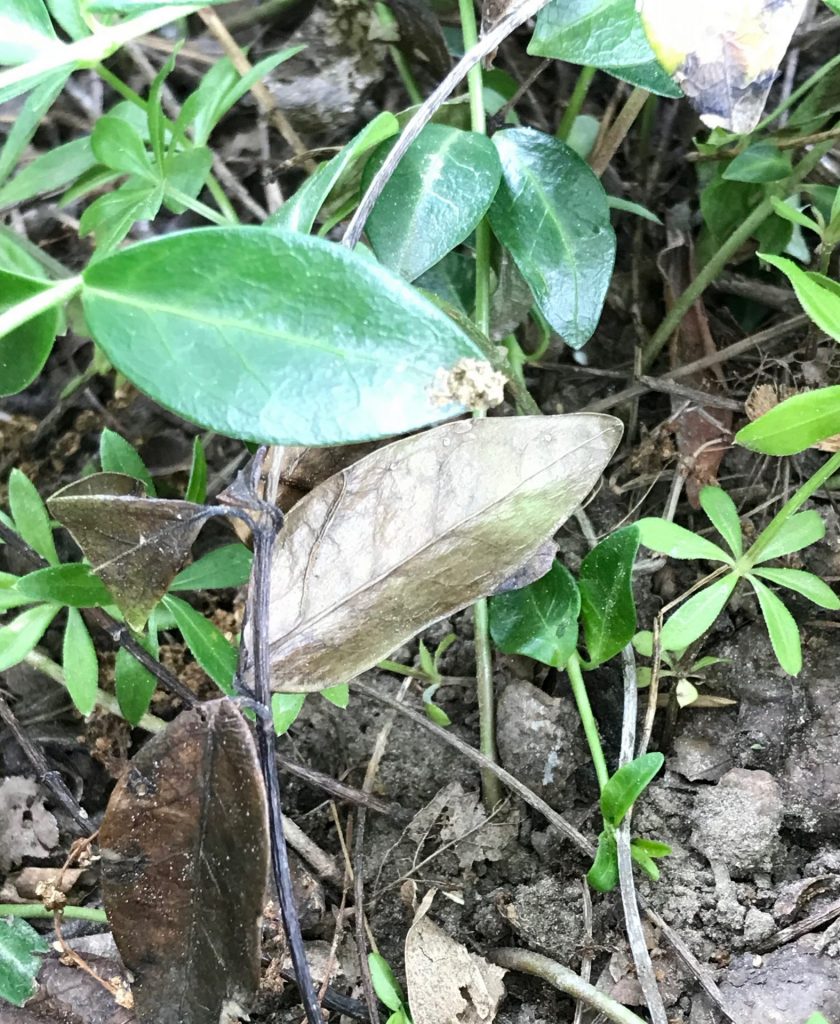
Many of my vinca ground-cover plants are dying back. These plants have been healthy for many years. Symptoms include: black stem, yellowing leaves that turn brown and fall off. I am hoping there is a way to reduce the spread. Thanks
Vinca minor (common periwinkle) is one of the most common groundcovers we see, and is an evergreen perennial. There are also annual vincas (Catharanthus roseus), which may be afflicted by the same or very different diseases. You mention that your plants have been healthy for many years, so I’m assuming your plants are the perennial vincas. This distinction is important as you do your research, so that you focus your search on information about Vinca minor.
From your description and photo, your plants may have been infected by a fungus. Two in particular come to mind:
Stem blight (caused by Phoma exigua var. exigua): This fungus grows in moist soil and plant debris and may persist in soil for long periods. Damage is most noticeable when the weather is cool and wet – in the spring or fall, although if the summer is cool and wet, new infections may be seen throughout the summer. Generally during hot, dry summers, the disease tapers off.
Symptoms include black lesions on the stems, followed by stems turning dark brown to black, wilting and dying. Whole clumps of vinca can fall prey to the fungus. It is believed that the fungus goes dormant over the winter, on dead stems and leaves, then starts growing in the spring just when the new leaves and shoots emerge. Spores are spread primarily by splashing water, e.g., from rain or when the area is watered.
Rhizoctonia is another fungus, which causes stem and root rot in vincas. The plants will turn yellow, wilt and die. Their roots will have brown rotted areas.
In both cases, control of the fungus may be very difficult to achieve and consists of removing dead plants and minimizing water contact with the remaining ones:
- Remove any dead/dying vinca, being sure to pull up all the roots, too – and dispose of these materials in the garbage (do not recycle). Work with the vinca plants when they are dry, so the disease won’t spread further. Make sure the bed where the vinca is growing is as free as possible of any other plant debris – don’t give the fungus any places to hide.
- Decrease the amount of water that reaches the leaves and/or the time the plant stays wet, to help suppress fungal infections. Do not overwater the plants and avoid overhead watering. Improve air circulation in the area by pruning nearby plants and overhanging branches.
If the above strategies do not work, fungicides may be used to prevent new infections. You would need to consult your local nursery for best options. Another consideration at that point would be to remove all the vinca and plant other groundcovers that are not susceptible to the fungi above.
For more information, see University of Illinois Extension. Vinca blight and root rot.
All the best with saving your vincas!
Note: As vinca is an invasive plant, we direct your attention to the Toronto Master Gardeners’ Statement on Invasive Plants: When choosing plants, avoid invasive plants, which can spread quickly and dominate gardens. Invasive plants are sold by nurseries, big box stores and even at community plant sales. Invasives may already be present in your garden. They can invade gardens by spreading from under a neighbour’s fence or may be transported by wildlife. For beautiful, sustainable options to invasive plants, see the Ontario Invasive Plant Council’s “Grow Me Instead – Beautiful Non-Invasive Plants for your Garden” before purchasing or accepting “gifts” of plants.

